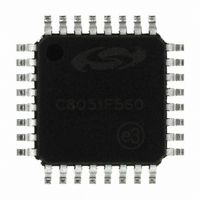C8051F560-IQ Silicon Laboratories Inc, C8051F560-IQ Datasheet - Page 143

C8051F560-IQ
Manufacturer Part Number
C8051F560-IQ
Description
IC 8051 MCU 32K FLASH 32-QFP
Manufacturer
Silicon Laboratories Inc
Series
C8051F56xr
Specifications of C8051F560-IQ
Program Memory Type
FLASH
Program Memory Size
32KB (32K x 8)
Package / Case
32-QFP
Core Processor
8051
Core Size
8-Bit
Speed
50MHz
Connectivity
SMBus (2-Wire/I²C), CAN, LIN, SPI, UART/USART
Peripherals
POR, PWM, Temp Sensor, WDT
Number Of I /o
25
Ram Size
2.25K x 8
Voltage - Supply (vcc/vdd)
1.8 V ~ 5.25 V
Data Converters
A/D 25x12b
Oscillator Type
Internal
Operating Temperature
-40°C ~ 125°C
Processor Series
C8051F5x
Core
8051
Data Bus Width
8 bit
Data Ram Size
2304 B
Maximum Clock Frequency
50 MHz
Number Of Programmable I/os
25
Operating Supply Voltage
1.8 V to 5.25 V
Maximum Operating Temperature
+ 125 C
Mounting Style
SMD/SMT
3rd Party Development Tools
PK51, CA51, A51, ULINK2
Development Tools By Supplier
C8051F560DK
Minimum Operating Temperature
- 40 C
Lead Free Status / RoHS Status
Lead free / RoHS Compliant
For Use With
336-1691 - KIT DEVELOPMENT FOR C8051F560
Eeprom Size
-
Lead Free Status / Rohs Status
Lead free / RoHS Compliant
Other names
336-1693
Available stocks
Company
Part Number
Manufacturer
Quantity
Price
Company:
Part Number:
C8051F560-IQ
Manufacturer:
Silicon Laboratories Inc
Quantity:
10 000
Company:
Part Number:
C8051F560-IQR
Manufacturer:
Silicon Laboratories Inc
Quantity:
10 000
- Current page: 143 of 302
- Download datasheet (3Mb)
17.2. Configuring the External Memory Interface
Configuring the External Memory Interface consists of four steps:
1. Configure the Output Modes of the associated port pins as either push-pull or open-drain (push-pull is
2. Configure Port latches to “park” the EMIF pins in a dormant state (usually by setting them to logic 1).
3. Select the memory mode (on-chip only, split mode without bank select, split mode with bank select, or
4. Set up timing to interface with off-chip memory or peripherals.
Each of these four steps is explained in detail in the following sections. The Port selection and Mode bits
are located in the EMI0CF register shown in SFR Definition .
17.3. Port Configuration
The External Memory Interface appears on Ports 1, 2 and 3 when it is used for off-chip memory access.
These ports are multiplexed so that low-order address lines are shared with the data lines. When the EMIF
is used, the Crossbar should be configured to skip over the /RD control line (P1.6) and the /WR control line
(P1.7) using the P1SKIP register and also skip over the ALE control line (P1.5). For more information
about configuring the Crossbar, see Section “19.6. Special Function Registers for Accessing and Configur-
ing Port I/O” on page 181. The EMIF pinout is shown inTable 17.1 on page 144.
The External Memory Interface claims the associated Port pins for memory operations ONLY during the
execution of an off-chip MOVX instruction. Once the MOVX instruction has completed, control of the Port
pins reverts to the Port latches or to the Crossbar settings for those pins. See Section “19. Port Input/Out-
put” on page 167 for more information about the Crossbar and Port operation and configuration. The Port
latches should be explicitly configured to “park” the External Memory Interface pins in a dormant
state, most commonly by setting them to a logic 1 .
During the execution of the MOVX instruction, the External Memory Interface will explicitly disable the driv-
ers on all Port pins that are acting as Inputs (Data[7:0] during a READ operation, for example). The Output
mode of the Port pins (whether the pin is configured as Open-Drain or Push-Pull) is unaffected by the
External Memory Interface operation, and remains controlled by the PnMDOUT registers. In most cases,
the output modes of all EMIF pins should be configured for push-pull mode.
most common), and skip the associated pins in the crossbar.
off-chip only).
Rev. 1.1
C8051F55x/56x/57x
143
Related parts for C8051F560-IQ
Image
Part Number
Description
Manufacturer
Datasheet
Request
R
Part Number:
Description:
SMD/C°/SINGLE-ENDED OUTPUT SILICON OSCILLATOR
Manufacturer:
Silicon Laboratories Inc
Part Number:
Description:
Manufacturer:
Silicon Laboratories Inc
Datasheet:
Part Number:
Description:
N/A N/A/SI4010 AES KEYFOB DEMO WITH LCD RX
Manufacturer:
Silicon Laboratories Inc
Datasheet:
Part Number:
Description:
N/A N/A/SI4010 SIMPLIFIED KEY FOB DEMO WITH LED RX
Manufacturer:
Silicon Laboratories Inc
Datasheet:
Part Number:
Description:
N/A/-40 TO 85 OC/EZLINK MODULE; F930/4432 HIGH BAND (REV E/B1)
Manufacturer:
Silicon Laboratories Inc
Part Number:
Description:
EZLink Module; F930/4432 Low Band (rev e/B1)
Manufacturer:
Silicon Laboratories Inc
Part Number:
Description:
I°/4460 10 DBM RADIO TEST CARD 434 MHZ
Manufacturer:
Silicon Laboratories Inc
Part Number:
Description:
I°/4461 14 DBM RADIO TEST CARD 868 MHZ
Manufacturer:
Silicon Laboratories Inc
Part Number:
Description:
I°/4463 20 DBM RFSWITCH RADIO TEST CARD 460 MHZ
Manufacturer:
Silicon Laboratories Inc
Part Number:
Description:
I°/4463 20 DBM RADIO TEST CARD 868 MHZ
Manufacturer:
Silicon Laboratories Inc
Part Number:
Description:
I°/4463 27 DBM RADIO TEST CARD 868 MHZ
Manufacturer:
Silicon Laboratories Inc
Part Number:
Description:
I°/4463 SKYWORKS 30 DBM RADIO TEST CARD 915 MHZ
Manufacturer:
Silicon Laboratories Inc
Part Number:
Description:
N/A N/A/-40 TO 85 OC/4463 RFMD 30 DBM RADIO TEST CARD 915 MHZ
Manufacturer:
Silicon Laboratories Inc
Part Number:
Description:
I°/4463 20 DBM RADIO TEST CARD 169 MHZ
Manufacturer:
Silicon Laboratories Inc











